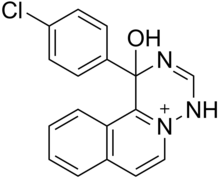Trazium
In this article, we will explore the impact of Trazium on different aspects of society. From his contributions in the scientific field to his influence on popular culture, Trazium has left his mark in countless fields. Throughout history, Trazium has been the object of debate and admiration, generating conflicting opinions and arousing the curiosity of millions of people around the world. In this sense, it is fascinating to analyze how Trazium has shaped the world we know today, as well as the implications its legacy has for the future. Therefore, this article aims to address the transversal impact that Trazium has had on society, providing a comprehensive vision of its relevance and significance.
 | |
| Clinical data | |
|---|---|
| Routes of administration | Oral |
| ATC code |
|
| Legal status | |
| Legal status |
|
| Identifiers | |
| |
| CAS Number | |
| PubChem CID | |
| ChemSpider | |
| UNII | |
| CompTox Dashboard (EPA) | |
| Chemical and physical data | |
| Formula | C17H13ClN3O |
| Molar mass | 310.76 g·mol−1 |
Trazium (EGYT-3,615) is an antidepressant drug which was never marketed. It has psychostimulant-like effects and its actions appear to be mediated by the dopaminergic and adrenergic systems. It was formulated as a salt with ethanesulfonic acid and given the generic name trazium esilate (INN).
References
- ^ David J. Triggle (1996). Dictionary of Pharmacological Agents. Boca Raton: Chapman & Hall/CRC. ISBN 0-412-46630-9.
- ^ Gyertyán I, Petöcz L, Bajnógel J, et al. (July 1989). "Possible involvement of the dopaminergic system in the mode of action of the potential antidepressant trazium esilate". Arzneimittel-Forschung. 39 (7): 775–81. PMID 2551306.
- ^ "Trazium Esilate". ChemSpider.[permanent dead link]
| |||||||||||||||||||||
| |||||||||||||||||||||
| |||||||||||||||||||||
| |||||||||||||||||||||
| |||||||||||||||||||||
| D1-like |
| ||||||
|---|---|---|---|---|---|---|---|
| D2-like |
| ||||||